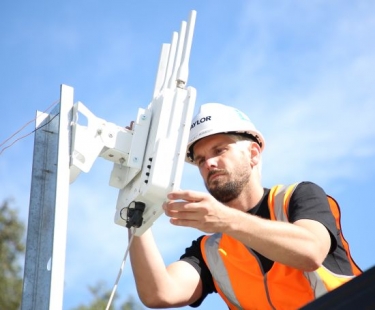While there have been many hypothetical use cases for 5G, and predictions about the business applications it will enable, Australian company Taylor Constructionhas demonstrated that 5G is a viable solution to the never-ending construction site data challenges.
Cradlepoint, a leader in cloud-delivered LTE and 5G wireless edge solutions, today announced that Taylor Construction has completed its 5G trial and is successfully using 5G for business solutions.
Following the February 2020 release of Cradlepoint's 5G wireless edge solutions, and its interaction with Telstra's high-performance 5G network, Taylor Construction identified a construction site where it could trial Telstra's Enterprise Wireless solution and Cradlepoint's NetCloud Service for Branch, delivered through a Cradlepoint E3000 5G-optimised router with a ruggedised W2005 5G Wideband Adapter built for outdoor placement.
"The Cradlepoint 5G solution, enabled by the Telstra 5G network, has transformed our ability to employ high-performing enterprise-grade applications, top to bottom," says Christian Neyle, IT manager for Taylor Construction. The performance the company is now getting with 5G will enable it to deploy its current 5G-ready high-tech applications, made possible by the Wireless WAN. Taylor is experimenting with the following applications:
- Holographic Building Visualisation — Microsoft HoloLens is a type of mixed-reality smart glasses that Taylor employees and customers can wear on-site to render a virtual model of the building or elements of the construction process such as holographic structural steel, framing, or electrical schematics.
- Wide-Area Safety Scanning — 360-degree 8K streaming and QR code scanning from wireless video cameras enables digital induction tracking, which improves risk management by automating the process of ensuring every person on site has completed safety training.
- IoT Structural Sensing — Smart sensors affixed to rebar and embedded in concrete aggregate and send data to the Cradlepoint router, then onto the cloud. This can help Taylor determine if concrete is poured correctly and track any shifting of the concrete for years to come.
- Real-Time Design Display — The Taylor team needs to be able to make changes to digital blueprints in real time and display on tablets and large monitors in the trailer.
- Large-Site Failover — The IT team also would like to investigate replacing their expensive back-up fibre line with 5G, gaining fibre-like speeds with the diversity of a wireless connection.
|
|
"To some people, this is science fiction [but] to me, this is the next generation of business," says Neyle. "We could have used fibre, but mobility was also important, which is why 5G is the only solution that works." All of these aforementioned devices and applications require real-time data, which is only possible with immense bandwidth, low latency, and constant uptime at the edge of the network." Neyle expands on those thoughts in this video.
"Taylor Construction is an example of how organisations can use 5G to transform their business and drive new ways to reduce costs, improve operational efficiency, and compete," says George Mulhern, CEO of Cradlepoint. "Taylor was able to leverage 5G to quickly implement innovative new applications, so can just about any business in any industry.
"Wireless WANs, based on the capabilities of 4G LTE and 5G technology, are becoming an essential part of any organisation's digital transformation," says Mulhern. "Cradlepoint NetCloud allows companies to manage both LTE and 5G networks under the same cloud platform, with the same operational, security and analytic capabilities. By deploying advanced LTE services today, companies can be ready to make a seamless transition to 5G when and where it's available in their network."
Of course there are plenty of advantages for early-movers, but iTWire is interested to know how the system continues to perform as nearby usage ramps up and Taylor's sites don't have near-exclusive use of the local 5G bandwidth. Time will tell.











































